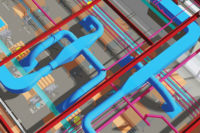“Typical guidelines say that more air means fewer contaminants lingering in a room,” says Marty Wallace, a senior associate at Genesys. “But high ventilation rates cost large sums of money and are not always necessary to control contaminant levels.”
As with any new approach, Genesys had to prove its point. That’s where upfront computational fluid dynamics (CFD) comes into play. Genesys worked with engineers from Blue Ridge Numerics, who used their own CFdesign software to simulate a new design that promises not only to eliminate contaminants more effectively, but to do so with nearly half the airflow of the existing configuration.
AGGRESSIVE PLAN
The project taken on by Genesys is part of an aggressive plan to cut the Yale School of Medicine’s energy consumption 25% to 30% below the criteria set forth in ASHRAE Standard 90.1, which provides guidelines for energy efficiency within the HVAC industry.The first building to be tackled under the plan is The Anlyan Center. It is the largest structure at the Yale School of Medicine, consuming 25% of the medical school’s total energy. The eight-story building, built in 2001, comprises 475,000 sq ft of research labs, a vivarium, an MRI suite, classrooms, offices, and support space. Initial work by Genesys centers on improving efficiency for a 1,800-sq-ft lab in The Anlyan Center that is typical in size and features.
COMBINED EXPERTISE
Genesys and Blue Ridge Numerics were natural partners for this project. Genesys has performed energy evaluations for more than 250 buildings over the past four years. The company specializes in laboratory facilities in universities, hospitals, research institutions, and industry.In addition to its CFdesign software, Blue Ridge Numerics brought to the table its experience in optimizing HVAC designs for computer-server rooms, retail stores, museums, office buildings, cleanrooms, aircraft hangers and other diverse structures. The company’s CFdesign software is categorized as an “upfront CFD” product. It enables mechanical engineers to conduct fluid flow and heat transfer simulation early in the product development process, where it can save the most time and money.
“We could not have proven our point without the simulations provided by CFdesign software,” says Wallace. “Upfront CFD was the only way we could analyze airflow patterns with any degree of confidence, without the exorbitant expense of constructing a full-scale model of the space.”
‘NO STONE UNTURNED'
Genesys started the project by studying the original drawings of the building, examining test and balance reports that document air quantities being delivered by the HVAC system, and reviewing control system schematics. The research was supplemented by hours of interviews with the school’s operating staff and hundreds of hours on-site examining every aspect of the building.“We had to determine how much systems could be modified given the constraints of existing construction,” says Wallace. There was also some sensitivity to the fact that the building is only eight years old, with systems considered fairly new by some standards.
“To its credit, Yale instructed us to ‘leave no stone unturned’ in our quest to find ways to save energy,” says Wallace. “We could see that current flow patterns were not enabling effective ventilation. The Yale School of Medicine staff agreed, and supported the idea of using upfront CFD to help illustrate the problem and proposed solutions.”
INITIAL TURBULENCE
Parker Wright and Jason Pfeiffer of Blue Ridge Numerics kicked off the analysis part of the project by visiting The Anlyan Center and taking detailed measurements of the lab room, capturing major features such as pendant lighting fixtures and bookshelves that affect airflow.Wright took the measurements and existing information on airflow rates and diffuser deflection angles and built a CAD model of the existing room in Autodesk Inventor. The model, containing only the essential features that impact airflow and contamination removal, was meshed automatically by CFdesign to ready it for simulation.
The simulations based on the existing layout showed exactly what Wallace thought they would.
“The CFdesign simulations proved beyond a reasonable doubt that the patterns were turbulent and not conducive to moving contaminants out of the room very effectively,” says Wallace. “They also validated many of the occupants’ complaints about uncomfortable drafts in certain parts of the room.”
VISUALIZING THE BEST SOLUTION
Wallace provided Wright with a modified diffuser layout that would provide more uniform flow from the windows, down the bench aisles, and to the fume hood and general exhausts. Although an improvement over the existing layout, the revised design resulted in too many drafts in the room when simulated in CFdesign. Two more diffuser locations needed to be designed and tested before Wallace and Wright settled on the best option.Moving from CAD to CFD and back again was made quicker and easier by CAD integration within CFdesign. Geometry from the CAD system was read directly into CFdesign and all CFdesign parameters were preserved when geometry was changed within the CAD system.
Wright modeled the best option in CAD. He then brought the model into CFdesign for testing with several air change rates, simulating heating, peak cooling and emergency flush modes. He also ran several chemical spill simulations to find out how long it took to clear most of the vapor from the room.
“Diffuser placements and throws have to be designed in concert with hood flows from support equipment and exhaust outlets,” says Wright. “Complex interaction among different elements couldn’t be fully understood until we ran the CFdesign simulations.
“The final arrangement promotes laminar (smooth) flow from diffuser (inlet) to exhaust grilles, clearing chemicals, reducing drafts, and resulting in a more sustainable design,” says Wright. “The results showed conclusively that the new layout, with less airflow, cleared the room of contaminants more quickly and effectively than the original layout.”
Having proven the premise that more is not necessarily less - at least as it applies to airflow and contaminant removal - Genesys has completed specs for a pilot project that will modify the lab room’s ducts and diffusers based on the results of CFdesign simulation.
“Blue Ridge’s upfront CFD capabilities saved us time, allowed for more iterations, and showed us something we couldn’t have seen otherwise,” says Wallace. “It’s tough to quantify, but I just can’t say enough how much easier it is to understand an airflow problem when you can see the graphic results.”ES



